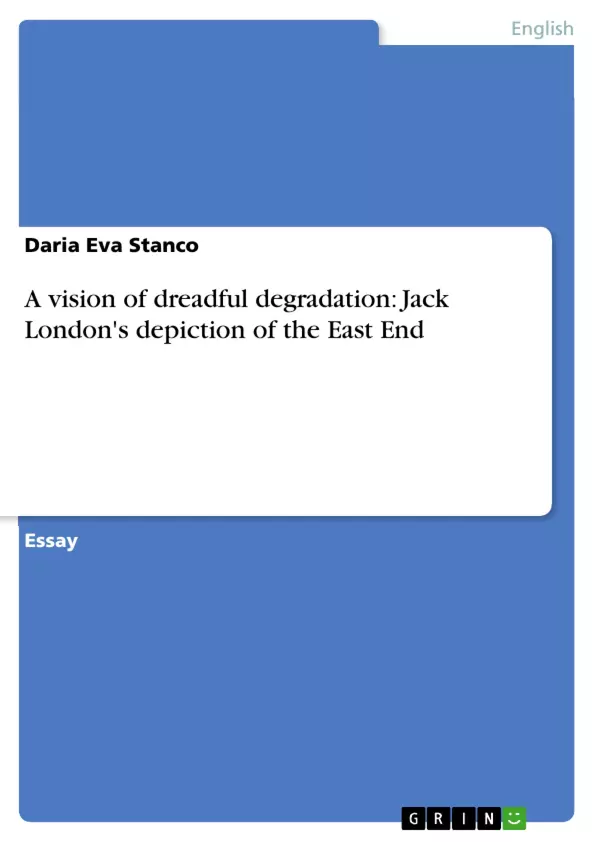“What is not good enough for you is not good enough for other men, and there’s no more to be said”, states the American writer Jack London in his book “The People Of The Abyss”. His work is a documentary account of the living and working conditions in the East End of London in 1902. In a sweeping style, the author presents the misery of the slums in the then worst areas. Being accused by many of sensationality, the book refers to the author’s own experiences as well as other accounts and statistics. “The People Of The Abyss” certainly is a piece of documentary literature in terms of a sociological study. Nevertheless, the author uses several literary tricks to attract the reader’s attention. By many critics, his picture of the East End of London has been called overdrawn. In this essay, this image of the East End in Jack London’s account will be sketched out. Beforehand, a short summary of his biography will be given in order to find out what caused him to write such a book. In the end, the former situation will be briefly compared to the East End of today.
Inhaltsverzeichnis (Table of Contents)
- Introduction
- Why did Jack London write this book?
- A vision of Dreadful Degradation: Jack London's depiction of the East End
- Conclusion
Zielsetzung und Themenschwerpunkte (Objectives and Key Themes)
Jack London's "The People Of The Abyss" is a documentary account of the living and working conditions in the East End of London in 1902. The book aims to expose the misery of the slums and the gap between the wealthy and the impoverished in London. London uses a combination of personal experience, other accounts, and statistics to paint a vivid picture of the situation.
- The social and economic conditions of the East End of London
- The impact of poverty and inequality on individuals and communities
- Jack London's own experiences and motivations for writing the book
- The role of capitalism and industrialization in creating social problems
- The contrast between the rich and poor in London
Zusammenfassung der Kapitel (Chapter Summaries)
- Introduction: This chapter introduces the reader to Jack London's "The People Of The Abyss" and its focus on the living conditions in the East End of London in 1902. London's personal experiences with poverty and his desire to shed light on social injustices are highlighted.
- Why did Jack London write this book?: This chapter explores Jack London's background and the events that led him to write "The People Of The Abyss." His own experiences with poverty and his socialist beliefs are discussed, as is his desire to expose the underside of imperialism and the degradation of the working class.
- A vision of Dreadful Degradation: Jack London's depiction of the East End: This chapter delves into Jack London's portrayal of the East End, highlighting the abysmal conditions in workhouses, the plight of the homeless, and the stark contrast between the wealth of the West End and the poverty of the East End. London's use of imagery, such as the "abyss," to describe the hopelessness and despair of the East End is explored.
Schlüsselwörter (Keywords)
The main keywords and focus topics of "The People Of The Abyss" include poverty, inequality, social injustice, East End of London, slums, workhouses, capitalism, industrialization, and the abyss. The book explores the harsh realities of poverty and the impact it has on individuals and communities, highlighting the stark contrast between the wealthy and the impoverished in London.
- Arbeit zitieren
- Daria Eva Stanco (Autor:in), 2007, A vision of dreadful degradation: Jack London's depiction of the East End, München, GRIN Verlag, https://www.grin.com/document/88423



